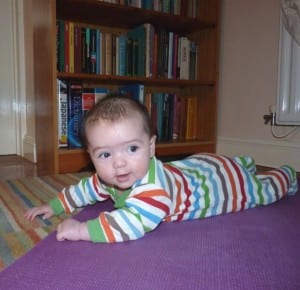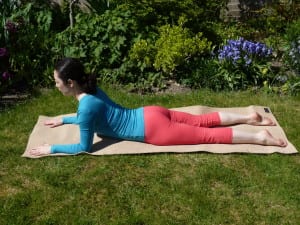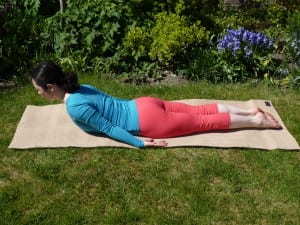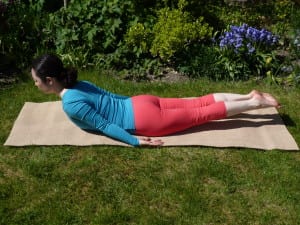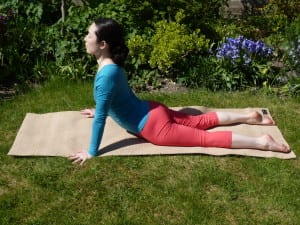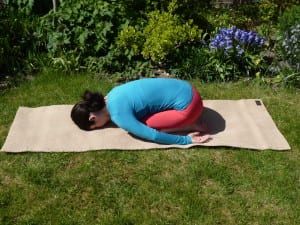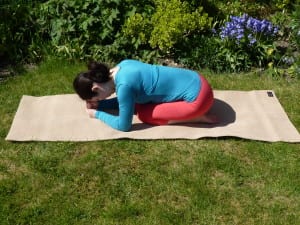After my post Yoga for lower back relief – 4 poses resonated with many, I wanted to share with you how selected backbends can be enormously helpful in both relieving and preventing lower back pain.
Backbends might seem like advanced and scary poses, only for the extremely flexible and fit. In reality there are backbends for everyone, and we have actually all already done those I share below. These are simple, foundational and highly therapeutic backbends that were part of our physical development as babies, hence this photo of the stripy poser (my son at 5 months).
This is great news: the body already ‘knows’ these poses inherently and they are (or at least were) natural to us. We can rediscover and benefit from them.
The way they help with lower back pain is to literally counter the all-too-common posture of slouching/rounding/collapsing in the lower back when sitting for long periods, driving, lifting, bending over etc. This compromises the intervertebral discs and musculature of the back, particularly in the lumbar region. The soft tissues become strained, over-stretched and weak. The front of the body also suffers: we experience a collapsing in the chest (and heart centre) with a rounding of the shoulders.
Regular practice of the poses below brings strength, stability and suppleness. They contribute to long-term good back health.
Gently practice them daily if your back feels strained and then every few days or weekly to maintain lower back health. Alternate them with the poses in my other back care post and ideally with a fully-dimensional yoga practice or regular class. As all structures of the body are profoundly connected, the latter will maintain the suppleness and strength of the back as an integral part of the whole body.
If you have issues with your back that are beyond ‘non-specific’ lower back pain, please consult your health advisor before beginning this practice. If you are given the go-ahead and still have doubts, even one or a few one-to-one lessons with a yoga teacher are invaluable to clarify the best technique to suit your body.
1. Sphinx pose
To start, lie on your front, feet hip-width apart. Feel grounded through your pelvis and drop the weight of the body into the earth.
Bend your arms and place your elbows so that they are under your shoulders. On an outbreath, press down through the forearms and slowly lift the chest and head. Drop the shoulders, releasing any tension in the upper body. Feel the length of the whole spine. Breathe naturally, without control or effort. Stay for 5 breaths in and out.
Exhale and exit (come back down to the ground) slowly.
2. Locust
This pose is the most effective for building strength in the back. It strengthens the deepest muscles either side of the spine.
Start as in pose 1, but this time with your arms by your sides, palms on the floor or turned upwards – go with what feels best for you. Feet can be either hip-width apart or together – again, see what feels best.
On an outbreath, take step one: lift the forehead, chin and chest slowly off the floor. Feel the deepest back muscles either side of the spine working and a lifting in the centre of the chest. The buttocks should remain soft in order to maintain space in the lower back. (However, if you sense any strain or loss of stability in the lower back, engage the buttocks.) Stay for 5 natural breaths in and out. Exit on an outbreath.
If it feels fine, try (or go straight to in future) step two: simultaneously lift the upper and lower body off the floor on the outbreath. Still maintain softness in the buttocks (see above for the exception to this). Stay for 5 natural breaths in and out. Exit on an outbreath.
3. Tall cobra
Begin as in pose 2, but with your hands in front of and broader than your shoulders. The exact distances will depend on your flexibility and proportions, so experiment with what feels most ‘right’ for you. Similarly, the distance between the feet will need to be judged to suit your body. Just be aware that with the feet further apart, you may feel some pressure in the sacrum/lower back, so take it easy.
On an outbreath straighten the arms (as far as is possible) and raise the torso. Feel your heart centre breathe and sing. Shoulders down. Neck long. Only come up as far as feels comfortable. Never force. The front of the pelvis may or may not come off the ground. It doesn’t matter which. Hands may turn outwards slightly. Stay for 5 natural breaths in and out. Exhale to exit slowly.
Child’s pose to close
Take this neutral pose to rest and bring the body into balance. Stay for 10-15 natural breaths in and out. Focus the mind on the breath and drop the weight of the entire body into the ground. Feel completely supported here. This is a deeply soothing pose that calms the mind. It has a feeling of nurturing and ease.
If your forehead doesn’t reach the ground, place the head on fists and cushions between the heels and buttocks if you need to.
To help your back during the day
Be mindful of your posture and movement during the day. Use a supportive cushion/block for the lower back when sitting at a desk or driving etc. When bending over to lift something up, bend from the knees and keep the back straight rather than bending from the waist with a rounded back. Take movement breaks during the day if you sit at a desk for long periods.
The key to maintaining good back health is to be gentle and consistent with our yoga practice and aware of our daily postural habits. This also instils a positive frame of mind in which we feel confident and re-assured in the knowledge that we know our own body and can help ourselves.
It really is possible, step by step. Keep going, gently.
I do hope this is helpful. Please feel free to share it with any friends who would also benefit from support for their back health.
Photos: author’s own
